Читать книгу The Christian’s Highest Good - Douglas Vickers - Страница 5
На сайте Литреса книга снята с продажи.
Preface
ОглавлениеThe principal proposition I address in this book is that the Christian’s highest good consists in “fellowship with the Father and with his Son Jesus Christ,” as the apostle John has stated that in the introduction to his first epistle. That fellowship follows from the redemptive work of Christ, and by reason of the renewing, regenerating work of the Holy Spirit of God in the soul an individual is admitted to the high privileges it conveys. By reason of its grounding in God the Father’s adoption of the Christian believers as sons of God, that fellowship is, at its very inception, indissoluble. The Christian believer’s summum bonum, his highest good, is to see God. That, in its ultimate sense, will accrue to the Christian in the day of our Lord’s appearing, when the vision of God will be full in the face of Christ in his glorified human nature. But while in this life it is not possible to see God with the eyes of flesh, the Christian’s highest good is to know God in fellowship with him.
The exposition of the meaning and implications of fellowship with God takes up a number of underlying and relevant issues. They have to do with both the essential and the official or redemptive identity of Christ, the extent of his propitiatory and intercessory work, and the manner in which those questions have been addressed in historic theology. Considered also are certain trends in thought which have influenced the changing patterns of the church’s statement of its evangel. This has required notice of the assumption of the competence of unaided human reason and the anthropocentric orientation it has fostered, as that has infiltrated its influence into the church’s statement of doctrine.
The book aims to clarify the practical and experiential significance of the fact that by God’s salvific grace two classes of people exist: those who are in fellowship with God and are “walking in the light,” to use the phrase from John’s epistle, and those who still “walk in the darkness.” The implications of that distinction are traced at some length in the context of an examination of the Christian character that is consistent with the privileged state of fellowship with God. A final chapter considers the Christian’s prospect that “when he [Christ] appears we shall be like him, for we shall see him as he is” (1 John 3:2).
As already indicated, in writing the following chapters I have been motivated and influenced by the text of the first epistle of John, though I have in no sense set out to provide a commentary on that highly important epistle. I acknowledge the influence of the valuable commentary on the first epistle of John by Robert S. Candlish, and as some aspects of my argument are dependent on it I make full acknowledgment of my indebtedness to it. Numerous commentaries on John’s epistle are available, and I have acknowledged at some points of the book the helpful expository suggestions of Martyn Lloyd-Jones.
Parts of the first three chapters contain material that first found its way into a paper on “Why did Jesus Christ come into the world?” delivered at a meeting of the New England Reformed Fellowship (NERF) in September, 2013. I thank the Rev. David Green and the Executive Committee of NERF for their hospitality on that occasion. Parts of the remaining chapters are dependent on a syllabus on the first epistle of John that I prepared for the adult Sunday School of the West Springfield Covenant Community Church, Massachusetts, and I record my gratitude to the Rev. Al LaValley who facilitated that class.
As has been the case with a long list of books and professional papers I acknowledge with gratitude the skillful editorial assistance of Ann Hopkins. I retain full responsibility for the blemishes and infelicities that remain.
